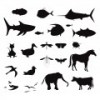Today was the final day of the meeting.

Dr. Joe Thompson (Franklin and Marshall College) spoke about oblique striated muscles, which get their name from the diagonal pattern formed by the location of the Z-lines. This type of muscle is common among cephalopods, nematodes, tunicates, molluscs, etc.
Dr. John Whiteman (University of Wyoming) gave a fascinating talk about polar bears and whether hunting on the shore as compared to the sea ice helped the animals replenish stores after hibernation or fasting as well as how foraging patterns affected activity levels.
Dr. Michael Butcher (Youngstown State University) presented data showing that sloths are remarkably not sloth-ful. They apparently have incredible grip strength and muscle resistance to fatigue in their hands and forearms as they are able to hang upside down and sleep without moving for hours.
A highlight of the evening was the Nobel lecture in Physiology or Medicine given by Dr. Roger Tsein, University of California, San Diego. As one would expect, he gave a fascinating lecture about his research on green fluorescent proteins (for which he received the Nobel prize in 2008). His work in this area is paving the way to improve surgical techniques for removing tumors by labeling them. In addition, he spoke about more recent research examining the extracellular matrix near synapses in the brain which may in fact be responsible for memory formation.
The Nobel lecture was followed by the closing reception for the American Physiological Society (APS), which featured the band, GI Distress, a band comprised of APS members. What a great way to end a fantastic conference. Here is a bit of history about the band:
https://youtu.be/0DGXjcy_J_g

